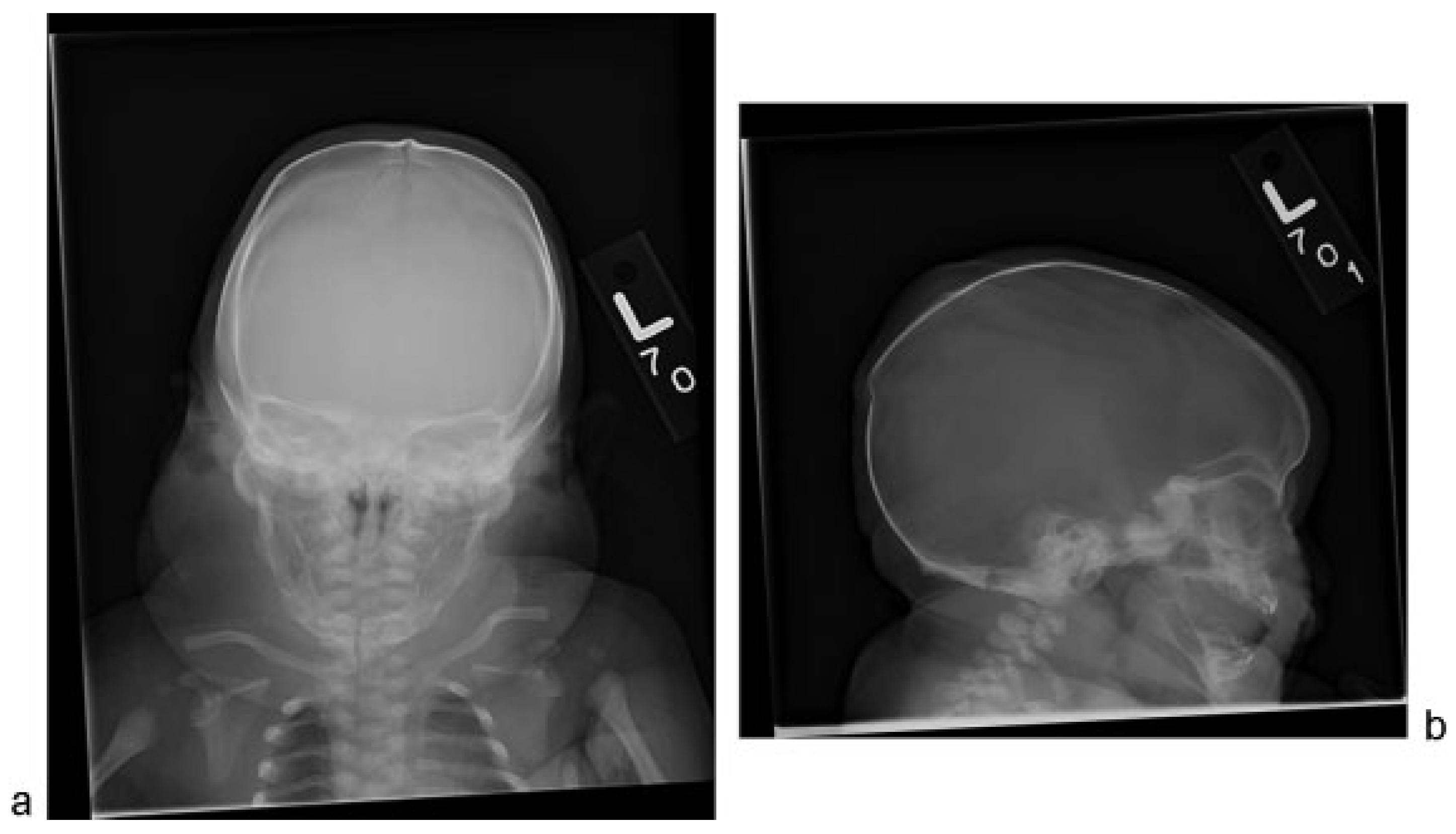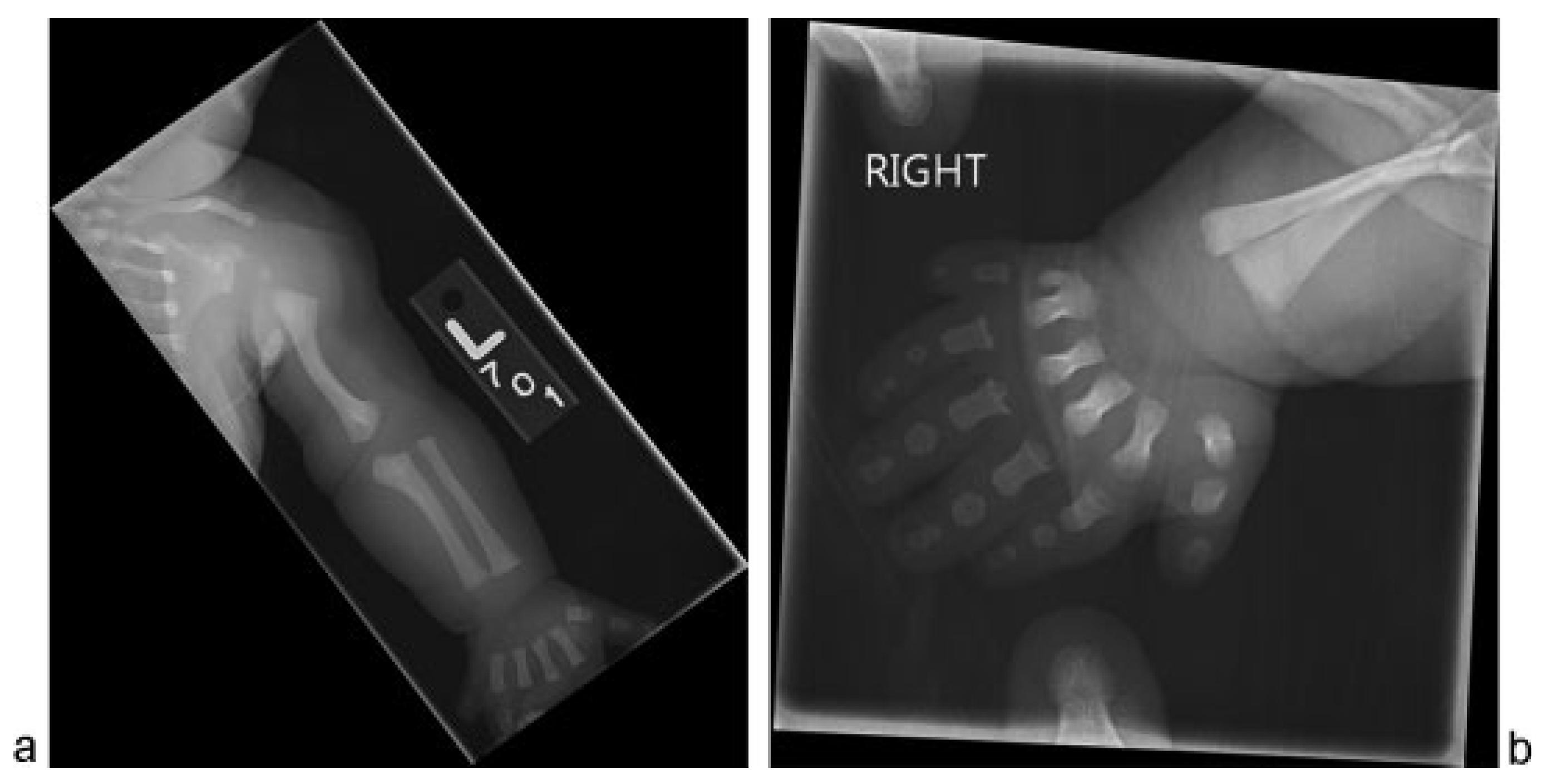Ellis–van Creveld Syndrome with Sagittal Craniosynostosis
Abstract
Case Report
Discussion
Products/Devices/Drugs
Financial Disclosures/Commercial Associations
References
- Ellis, R.W.; van Creveld, S. A syndrome characterized by ectodermal dysplasia, polydactyly, chondro-dysplasia and congenital morbius cordis: Report of three cases. Arch Dis Child 1940, 15, 65–84. [Google Scholar] [CrossRef] [PubMed]
- McKusick, V.A.; Egeland, J.A.; Eldridge, R.; Krusen, D.E. Dwarfism in the Amish I. The Ellis-van Creveld syndrome. Bull Johns Hopkins Hosp 1964, 115, 306–336. [Google Scholar] [PubMed]
- McKusick, V.A. Ellis-van Creveld syndrome and the Amish. Nat Genet 2000, 24, 203–204. [Google Scholar] [CrossRef] [PubMed]
- Digilio, M.C.; Marino, B.; Ammirati, A.; Borzaga, U.; Giannotti, A.; Dallapiccola, B. Cardiac malformations in patients with oral-facialskeletal syndromes: Clinical similarities with heterotaxia. Am J Med Genet 1999, 84, 350–356. [Google Scholar] [CrossRef]
- Ruiz-Perez, V.L.; Ide, S.E.; Strom, T.M.; et al. Mutations in a new gene in Ellis-van Creveld syndrome and Weyers acrodental dysostosis. Nat Genet 2000, 24, 283–286. [Google Scholar] [CrossRef] [PubMed]
- Ruiz-Perez, V.L.; Tompson, S.W.; Blair, H.J.; et al. Mutations in two nonhomologous genes in a head-to-head configuration cause Ellis-van Creveld syndrome. Am J Hum Genet 2003, 72, 728–732. [Google Scholar] [CrossRef] [PubMed]
- Tompson, S.W.; Ruiz-Perez, V.L.; Blair, H.J.; et al. Sequencing EVC and EVC2 identifies mutations in two-thirds of Ellis-van Creveld syndrome patients. Hum Genet 2007, 120, 663–670. [Google Scholar] [CrossRef] [PubMed]
- Fearon, J.A.; McLaughlin, E.B.; Kolar, J.C. Sagittal craniosynostosis: Surgical outcomes and long-term growth. Plast Reconstr Surg 2006, 117, 532–541. [Google Scholar] [CrossRef] [PubMed]
- Tatum, S.A.; Jones, L.R.; Cho, M.; Sandhu, R.S. Differential management of scaphocephaly. Laryngoscope 2012, 122, 246–253. [Google Scholar] [CrossRef] [PubMed]
- Badano, J.L.; Mitsuma, N.; Beales, P.L.; Katsanis, N. The ciliopathies: An emerging class of human genetic disorders. Annu Rev Genomics Hum Genet 2006, 7, 125–148. [Google Scholar] [CrossRef] [PubMed]
- Bhat, Y.J.; Baba, A.N.; Manzoor, S.; Qayoom, S.; Javed, S.; Ajaz, H. Ellis-van Creveld syndrome with facial hemiatrophy. Indian J Dermatol Venereol Leprol 2010, 76, 266–269. [Google Scholar] [CrossRef] [PubMed]
- Baujat, G.; Le Merrer, M. Ellis-van Creveld syndrome. Orphanet J Rare Dis 2007, 2, 27. [Google Scholar] [CrossRef] [PubMed]
- Young, I.D. Cranioectodermal dysplasia (Sensenbrenner’s syndrome). J Med Genet 1989, 26, 393–396. [Google Scholar] [CrossRef] [PubMed][Green Version]




© 2014 by the author. The Author(s) 2014.
Share and Cite
Fischer, A.S.; Weathers, W.M.; Wolfswinkel, E.M.; Bollo, R.J.; Hollier, L.H., Jr.; Buchanan, E.P. Ellis–van Creveld Syndrome with Sagittal Craniosynostosis. Craniomaxillofac. Trauma Reconstr. 2015, 8, 132-135. https://doi.org/10.1055/s-0034-1393733
Fischer AS, Weathers WM, Wolfswinkel EM, Bollo RJ, Hollier LH Jr., Buchanan EP. Ellis–van Creveld Syndrome with Sagittal Craniosynostosis. Craniomaxillofacial Trauma & Reconstruction. 2015; 8(2):132-135. https://doi.org/10.1055/s-0034-1393733
Chicago/Turabian StyleFischer, Andrew S., William M. Weathers, Erik M. Wolfswinkel, Robert J. Bollo, Larry H. Hollier, Jr., and Edward P. Buchanan. 2015. "Ellis–van Creveld Syndrome with Sagittal Craniosynostosis" Craniomaxillofacial Trauma & Reconstruction 8, no. 2: 132-135. https://doi.org/10.1055/s-0034-1393733
APA StyleFischer, A. S., Weathers, W. M., Wolfswinkel, E. M., Bollo, R. J., Hollier, L. H., Jr., & Buchanan, E. P. (2015). Ellis–van Creveld Syndrome with Sagittal Craniosynostosis. Craniomaxillofacial Trauma & Reconstruction, 8(2), 132-135. https://doi.org/10.1055/s-0034-1393733


